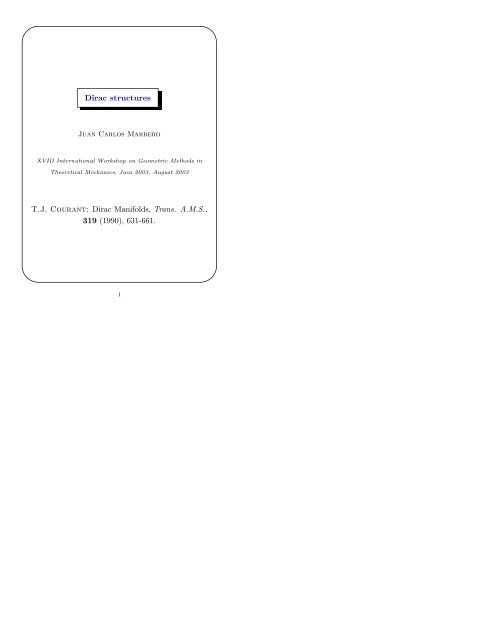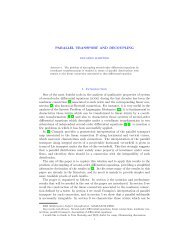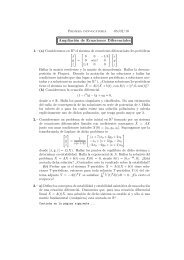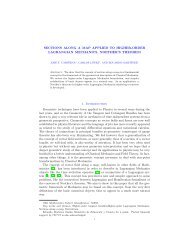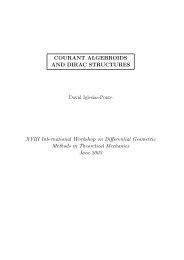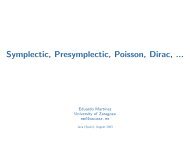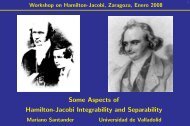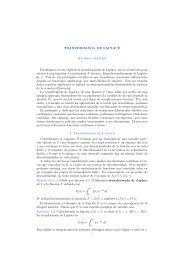Dirac structures TJ Courant: Dirac Manifolds, Trans. AMS, 319 (1990 ...
Dirac structures TJ Courant: Dirac Manifolds, Trans. AMS, 319 (1990 ...
Dirac structures TJ Courant: Dirac Manifolds, Trans. AMS, 319 (1990 ...
Create successful ePaper yourself
Turn your PDF publications into a flip-book with our unique Google optimized e-Paper software.
✬<br />
✩<br />
<strong>Dirac</strong> <strong>structures</strong><br />
Juan Carlos Marrero<br />
XVIII International Workshop on Geometric Methods in<br />
Theoretical Mechanics, Jaca 2003, August 2003<br />
T.J. <strong>Courant</strong>: <strong>Dirac</strong> <strong>Manifolds</strong>, <strong>Trans</strong>. A.M.S.,<br />
<strong>319</strong> (<strong>1990</strong>), 631-661.<br />
✫<br />
✪<br />
1
✬<br />
✩<br />
Scheme of the talk<br />
I LINEAR DIRAC STRUCTURES<br />
I.1 Linear <strong>Dirac</strong> <strong>structures</strong> on a vector space<br />
I.2 Basis of a linear <strong>Dirac</strong> structure<br />
I.3 Induced linear <strong>Dirac</strong> <strong>structures</strong><br />
II SMOOTH DIRAC STRUCTURES<br />
II.1 Lie algebroids<br />
II.2 Almost-<strong>Dirac</strong> <strong>structures</strong> on manifolds<br />
II.3 <strong>Dirac</strong> <strong>structures</strong> on manifolds<br />
II.4 The Poisson bracket on admissible functions<br />
II.5 <strong>Dirac</strong> <strong>structures</strong> as Poisson <strong>structures</strong> on<br />
quotient manifolds<br />
II.6 Darboux coordinates around a regular point<br />
II.7 Induced <strong>Dirac</strong> <strong>structures</strong><br />
✫<br />
✪<br />
2
✬<br />
✩<br />
Linear <strong>Dirac</strong> Structures<br />
I.1 <strong>Dirac</strong> <strong>structures</strong> on a vector space<br />
V a real vector space of finite dimension<br />
< , > + the natural symmetric pairing on V ⊕ V ∗<br />
< (x, α), (y, β) > + = 1 ∗<br />
{α(y)+β(x)}, (x, α), (y, β) ∈ V ⊕V<br />
2<br />
< , > − the natural skew-symmetric pairing on V ⊕ V ∗<br />
< (x, α), (y, β) > − = 1 ∗<br />
{α(y)−β(x)}, (x, α), (y, β) ∈ V ⊕V<br />
2<br />
L a subspace of V ⊕ V ∗<br />
L a linear <strong>Dirac</strong> structure on V<br />
⇕<br />
L is maximally isotropic under < , > +<br />
L a subspace of V ⊕ V ∗<br />
dim L = r dim L ∩ V ∗ = r − s<br />
⇓<br />
{(e 1 , α 1 ), . . . , (e s , α s ), (0, α s+1 ), . . . , (0, α r )} a basis of L<br />
and {e 1 , . . . , e s } are linearly independent<br />
✫<br />
3<br />
✪
✬<br />
✩<br />
Theorem: L a subspace of V ⊕ V ∗<br />
L a linear <strong>Dirac</strong> structure on V ⇔ L = L ⊥<br />
⇔ L is isotropic and dim L = dim V<br />
Examples:<br />
i) A : V → V ∗ a linear skew-symmetric map<br />
⇓<br />
graphA = {(x, A(x)) ∈ V ⊕ V ∗ /x ∈ V }<br />
linear <strong>Dirac</strong> structure on V<br />
ii) B : V ∗ → V a linear skew-symmetric map<br />
⇓<br />
graphB = {(B(x), α) ∈ V ⊕ V ∗ /α ∈ V ∗ }<br />
linear <strong>Dirac</strong> structure on V<br />
✫<br />
✪<br />
4
✬<br />
✩<br />
Characteristic equations of a linear <strong>Dirac</strong> structure<br />
ρ : V ⊕V ∗ → V, ρ ∗ : V ⊕V ∗ → V ∗ canonical projections<br />
L a linear <strong>Dirac</strong> structure<br />
L ∩ V ∗ ⊆ ρ(L) 0 , dim ρ(L) 0 = dim L ∩ V ∗<br />
⇓<br />
ρ(L) 0 = L ∩ V ∗<br />
ρ ∗ (L) ⊆ (L ∩ V ) 0 , dim ρ ∗ (L) = dim(L ∩ V ) 0<br />
⇓<br />
ρ ∗ (L) = (L ∩ V ) 0<br />
✫<br />
✪<br />
5
✬<br />
✩<br />
Theorem:<br />
A <strong>Dirac</strong> structure on a vector space V<br />
is equivalently defined as a subspace together with<br />
a skew-symmetric 2-form on it<br />
• E a subspace of V, Ω E : E × E → R a 2-form on E<br />
⇓<br />
L = {(x, α) ∈ V ⊕ V ∗ /x ∈ E, α |E = i(x)Ω E }<br />
linear <strong>Dirac</strong> structure on V<br />
• L a <strong>Dirac</strong> structure on V<br />
⇓<br />
E = ρ(L)<br />
Ω E : E × E → R a 2-form on E<br />
Ω E (x, y) = α(y) if (x, α) ∈ L<br />
Remark:<br />
L a <strong>Dirac</strong> structure on V<br />
⇓<br />
ker Ω ρ(L) = L ∩ V<br />
✫<br />
✪<br />
6
✬<br />
✩<br />
L ⊆ V ⊕ V ∗ a linear <strong>Dirac</strong> structure on V<br />
⇓<br />
π L a 2-vector on V/L ∩ V<br />
(V/L ∩ V ) ∗ ∼ = (L ∩ V ) 0 = ρ ∗ (L)<br />
π L : ρ ∗ (L) × ρ ∗ (L) → R<br />
π L (α, β) = β(u),<br />
if (u, α) ∈ L<br />
π L (α, β) = 0, ∀β ⇔ α(v) = 0, ∀v ∈ ρ(L) ⇔ α ∈ ρ(L) 0 =L ∩ V ∗<br />
ker π L = L ∩ V ∗<br />
rank π L = dim(V/V ∩ L) ∗ − dim(L ∩ V ∗ )<br />
= dim V − (dim L ∩ L + dim L ∩ V ∗ )<br />
✫<br />
7<br />
✪
✬<br />
I.2 Basis of a linear <strong>Dirac</strong> structure<br />
L ⊆ V ⊕ V ∗ a linear <strong>Dirac</strong> structure on V<br />
✩<br />
a : R n → V,<br />
dim V = n<br />
A basis of L<br />
⇓<br />
b : R n → V ∗ linear maps<br />
{(ae 1 , be 1 ), . . . , (ae n , be n )} basis of L<br />
Isotropic character of L<br />
⇓<br />
dim L = n<br />
⇓<br />
a ∗ ◦ b + b ◦ a ∗ = 0 ker a ∩ ker b = {0} (1)<br />
a : R n → V, b : R n → V ∗ linear maps which satisfy (1)<br />
L = {(ax, bx)/x ∈ R n } a linear <strong>Dirac</strong> structure on V<br />
An application:<br />
V a real vector space of finite dimension<br />
< , >: V × V → R an scalar product onV<br />
♭ < , > : V → V ∗ linear isomorphism<br />
I(V ) = {φ : V → V/φ is a linear isometry}<br />
⇓<br />
✫<br />
Theorem: There exists a one-to-one correspondence<br />
between the set of linear <strong>Dirac</strong> <strong>structures</strong><br />
on V and I(V )<br />
8<br />
✪
✬<br />
✩<br />
Proof: ” ← ”) φ : V → V a linear isometry<br />
⇓<br />
L = {(x + φ(x), ♭ < , > (x) − ♭ < , > (φ(x))) ∈ V × V ∗ /x ∈ V }<br />
is a linear <strong>Dirac</strong> structure on V<br />
” → ” L ⊆ V ⊕ V ∗ a linear <strong>Dirac</strong> structure on V<br />
a : R n → V,<br />
b : R n → V ∗ a basis of L<br />
¯b = ♭< , > ◦ b : R n → V ∗ → V<br />
⇓<br />
a + ¯b, a − ¯b : R n → V are linear isomorphies<br />
φ = (a + ¯b) ◦ (ā − ¯b) −1 : V → V is a linear isometry<br />
φ does not depend on the basis (a, b) of L<br />
Corollary: There exists a one-to-one correspondence<br />
between linear <strong>Dirac</strong> <strong>structures</strong> on R n<br />
and the orthogonal group O(n) of order n<br />
✫<br />
9<br />
✪
✬<br />
✩<br />
I.3 Induced linear <strong>Dirac</strong> <strong>structures</strong><br />
V a real vector space of finite dimension<br />
W a subspace of V<br />
L a <strong>Dirac</strong> structure on V<br />
E = ρ(L), Ω E : E × E → R the corresponding 2-form<br />
E W = E ∩ W = ρ(L) ∩ W, Ω EW = (Ω E ) |E∩W<br />
⇓<br />
L W ≡ (E W , Ω EW )) a linear <strong>Dirac</strong> structure on W<br />
An alternative description<br />
L W = L ∩ (W ⊕ V ∗ )<br />
L ∩ ({0} ⊕ W 0 )<br />
ker Ω EW = L W ∩ W ∼ = L ∩ (W ⊕ W 0 )<br />
L ∩ ({0} ⊕ W 0 )<br />
✫<br />
✪<br />
10
✬<br />
✩<br />
II. Smooth <strong>Dirac</strong> Structures<br />
II.1 Lie algebroids<br />
A → P a real vector bundle over P<br />
([ , ], ρ) a Lie algebroid structure on A<br />
i) [ , ] : Γ(A) × Γ(A) → Γ(A) is a Lie braket<br />
ii) ρ : A → T P a homomorphism of vector<br />
bundles and<br />
[X, fY ] = f [X, Y ] + ρ(X)(f)Y,<br />
X, Y ∈ Γ(A), f ∈ C ∞ (P, R)<br />
Remark: i) + ii) ⇒ ρ : Γ(A) → X(P ) is a Lie algebra<br />
homomorphism<br />
Theorem: ([ , ], ρ) Lie algebroid structure on A<br />
⇒ x ∈ M → ρ(A)(x) ⊆ T x P defines a generalized<br />
foliation on P<br />
✫<br />
11<br />
✪
✬<br />
✩<br />
Examples: i) P a smooth manifold<br />
⇓<br />
(T P, [ , ], Id) is a Lie algebroid on P<br />
ii) (P, π) a Poisson manifold(⇔ π ∈ V 2 (M), [π, π] SN = 0)<br />
⇓<br />
(T ∗ P, [ , ] π , # π ) is a Lie algebroid<br />
[α, β ] π = L #π (α)β − L #π (β)α − d(π(α, β))<br />
β(# π (α)) = π(α, β),<br />
α, β ∈ Ω 1 (M)<br />
✫<br />
✪<br />
12
✬<br />
✩<br />
II.2 Almost-<strong>Dirac</strong> <strong>structures</strong> on manifolds<br />
P a smooth manifold (dim P = m)<br />
Natural symmetric and skew-symmetric pairings on<br />
T P ⊕ T ∗ P<br />
< (X, α), (Y, β) > + = 1 (α(Y ) + β(X))<br />
2<br />
< (X, α), (Y, β) > − = 1 (α(Y ) − β(X))<br />
2<br />
X, Y ∈ T p P, α, β ∈ T ∗ p P<br />
L a vector subbundle of T P ⊕ T ∗ P<br />
Definition: L is an almost-<strong>Dirac</strong> structure on P ⇔<br />
L P<br />
is a linear <strong>Dirac</strong> structure on T p P , for all p ∈ P<br />
Corollary: The following conditions are equivalent:<br />
(i)L is an almost-<strong>Dirac</strong> structure on P<br />
(ii) L is a maximally isotropic vector subbundle<br />
of T P ⊕ T ∗ P under < , > +<br />
(iii) L = L ⊥<br />
(iv) L is a isotropic vector subbundle of<br />
T P ⊕ T ∗ P of rank m<br />
✫<br />
13<br />
✪
✬<br />
L an almost-<strong>Dirac</strong> structure on P<br />
ρ : T P ⊕ T ∗ P → T P,<br />
canonical projections<br />
ρ ∗ : T P ⊕ T ∗ P → T ∗ P<br />
Characteristic equations of L<br />
ρ(L) 0 = L ∩ T ∗ P, ρ ∗ (L) = (L ∩ T P ) 0<br />
✩<br />
The 2-form Ω L : ρ(L) → ρ(L) ∗<br />
ker Ω L = L ∩ T P<br />
Examples: i) Poisson <strong>structures</strong><br />
π : T ∗ P → T P a Poisson structure on P<br />
⇓<br />
L π = graphπ = {(# π (α), α) ∈ T P ⊕ T ∗ P/α ∈ T ∗ P }<br />
almost-<strong>Dirac</strong> structure on P<br />
ρ(L π ) = im(π) symplectic foliation associated with π<br />
L π ∩ T P = {0} ⇒ ρ ∗ (L π ) = T ∗ P<br />
Ω Lπ<br />
is a non-degenerate 2-form<br />
S p the symplectic leaf passing through p<br />
⇓<br />
Ω Lπ |S p<br />
✫<br />
is the symplectic 2-form on S p<br />
14<br />
✪
✬<br />
✩<br />
ii) Presymplectic <strong>structures</strong><br />
Ω : T P → T ∗ P a closed 2-form on P<br />
⇓<br />
L Ω = graphΩ = {(x, i(x)Ω)/x ∈ T P }<br />
an almost-<strong>Dirac</strong> structure on P<br />
ρ(Ω) = T P<br />
⇓<br />
The foliation associated with L Ω has an only leaf: P<br />
L Ω ∩ T P = ker Ω<br />
Additional <strong>structures</strong> in i) and ii)<br />
[π, π] SN = 0<br />
dΩ = 0<br />
⇓<br />
<strong>Dirac</strong> <strong>structures</strong> on manifolds<br />
✫<br />
✪<br />
15
✬<br />
✩<br />
II.3 <strong>Dirac</strong> <strong>structures</strong> on manifolds<br />
P a smooth manifold<br />
The <strong>Courant</strong> bracket on Γ(T P ⊕ T ∗ P ) ∼ = X(P ) × Ω 1 (P )<br />
[(X, α), (Y, β)] = ([X, Y ], L X β − L Y α + d <<br />
(X, α), (Y, β) > − )<br />
L an almost-<strong>Dirac</strong> structure on P<br />
T L (e 1 , e 2 , e 3 ) =< [e 1 , e 2 ], e 3 > + , e i ∈ Γ(L)<br />
Define T ∈ Γ(∧ 3 (T P ⊕ T ∗ P ) ∗ )<br />
T ((X, α), (Y, β), (Z, γ)) = −{dα(Y, Z)+dβ(Z, X)+dγ(X, Y )<br />
+X(< (Y, β), (Z, γ) > − ) + Y (< (Z, γ), (X, α) > − )+<br />
Z(< (X, α), (Y, β) > − )}<br />
Proposition T L = T |Γ(L)×Γ(L)×Γ(L) . In particular,<br />
T L ∈ Γ(∧ 3 L ∗ )<br />
Proposition: (X, α), (Y, β), (Z, γ) ∈ Γ(L), f ∈ C ∞ (P, R)<br />
⇓<br />
• [(X, α), f(Y, β)] = f[(X, α), (Y, β)] + X(f)(Y, β)<br />
• [[(X, α), (Y, β)], (Z, γ)] + [[(Y, β), (Z, γ)], (X, α)] +<br />
[[(Z, γ), (X, α)], (Y, β)] = (0, dT L ((X, α), (Y, β), (Z, γ))))<br />
✫<br />
16<br />
✪
✬<br />
✩<br />
Definition: L a <strong>Dirac</strong> structure on P ⇔<br />
Γ(L) is closed under the bracket [ , ]<br />
Theorem: If L is an almost-<strong>Dirac</strong> structure<br />
on P , then the following conditions are<br />
equivalent:<br />
(i) L is a <strong>Dirac</strong> structure on P<br />
(ii) T L identically vanishes<br />
(iii) (L, [ , ] |Γ(L)×Γ(L) , ρ |L ) is a Lie algebroid<br />
Corollary: L a <strong>Dirac</strong> structure on P ⇒<br />
ρ(L) generates a singular foliation on P<br />
✫<br />
17<br />
✪
✬<br />
✩<br />
L a <strong>Dirac</strong> structure on P<br />
F a leaf of ρ(L)<br />
⇓<br />
Ω F a 2-form on F<br />
y ∈ F → Ω F (y) = Ω L (y) : T y F × T y F → R<br />
X 1 (y), X 2 (y), X 3 (y) ∈ T y F/X i (y) = ρ L (e i (y))<br />
e i (y) ∈ L y , ∀i ∈ {1, 2, 3}<br />
⇓<br />
dΩ F (y)(X 1 (y), X 2 (y), X 3 (y)) =<br />
T L (y)(e 1 (y), e 2 (y), e 3 (y)) = 0<br />
Theorem: If L is a <strong>Dirac</strong> structure on P<br />
then there exits a generalized foliation<br />
on P whose leaves are presymplectic<br />
manifolds.<br />
✫<br />
✪<br />
18
✬<br />
✩<br />
Examples: i) Poisson manifolds<br />
π a Poisson structure on P<br />
⇓<br />
L π = {(# π (α), α) ∈ T P ⊕ T ∗ P/α ∈ T ∗ P } a <strong>Dirac</strong><br />
structure on P<br />
L π → T ∗ P,<br />
((# π )(α), α) → α<br />
a Lie algebroid isomorphism<br />
ρ(L π )(y) = # π (T ∗ y P ),<br />
∀y ∈ P<br />
Ω Lπ is symplectic on each leaf of ρ(L π )<br />
⇓<br />
Characteristic foliation of L π<br />
Symplectic foliation of (P, π)<br />
ii) Presymplectic <strong>structures</strong><br />
Ω a closed 2-form on P<br />
⇓<br />
L Ω = {(X, i(X)Ω) ∈ T P ⊕ T ∗ P/X ∈ T P }<br />
a <strong>Dirac</strong> structure on P<br />
L Ω → T P,<br />
(X, i(X)Ω) → X<br />
a Lie algebroid isomorphism<br />
The characteristic foliation of L Ω has a unique<br />
leaf: the manifold P<br />
✫<br />
19<br />
✪
✬<br />
✩<br />
II.4 The Poisson bracket on admissible functions<br />
L a <strong>Dirac</strong> structure on P<br />
f ∈ C ∞ (P, R)<br />
Definition: f is admissible ⇔ df ∈ ρ ∗ (L) ⇔<br />
∃X f ∈ X(P )/e f = (X f , df) ∈ Γ(L)<br />
f admissible ⇒ X f the hamiltonian vector field of f<br />
C ∞ a (P, R) = {f ∈ C ∞ (P, R)/f is admissible}<br />
f, g ∈ C ∞ a (P, R)<br />
e f = (X f , df) ∈ Γ(L),<br />
e g = (X g , dg) ∈ Γ(L)<br />
⇓<br />
{f, g} L = X f (g) = Ω L (X f , X g )<br />
Theorem: (C ∞ a (P, R), { , } L ) is a Poisson algebra<br />
✫<br />
20<br />
✪
✬<br />
✩<br />
Proof: f, g, h ∈ C ∞ a (P, R)<br />
e f = (X f , df) ∈ Γ(L) , e g = (X g , dg) ∈ Γ(L), e h =<br />
(X h , dh) ∈ Γ(L)<br />
i) [e f , e g ] = ([X f , X g ], d{f, g} L ) ∈ Γ(L)<br />
⇓<br />
{f, g} L ∈ C ∞ a (P, R)<br />
ii) fe g + ge f = (fX g + gX f , d(fg)) ∈ Γ(L)<br />
⇓<br />
fg ∈ C ∞ a (P, R), X fg = fX g + gX f<br />
⇓<br />
{fg, h} L = f{g, h} L + g{f, h} L<br />
iii) 0 = T L (e f , e g , e h ) = +<br />
= {f, {g, h} L } L + {g, {h, f} L } L + {h, {f, g} L } L<br />
✫<br />
21<br />
✪
✬<br />
II.5 <strong>Dirac</strong> <strong>structures</strong> as Poisson <strong>structures</strong><br />
on quotient manifolds<br />
L a <strong>Dirac</strong> structure on P , dim P = m<br />
Assumption 1: L ∩ T P is a vector subbundle of T P<br />
of rank r ⇔ dim L p ∩ T p P = r, ∀p ∈ P<br />
✩<br />
ker Ω L = L ∩ T P<br />
⇓<br />
L ∩ T P defines a foliation F on P<br />
Assumption 2: F is a regular foliation on P in such<br />
a way that the space of leaves ˆP = P/F is a smooth<br />
manifold and the canonical projection τ : P → ˆP is a<br />
submersion<br />
Theorem:<br />
is a Poisson manifold<br />
The quotient space ˆP = P/F<br />
Proof:<br />
ρ ∗ (L) = (L ∩ T P ) 0<br />
⇓<br />
✫<br />
τ ∗ : C ∞ ( ˆP , R) → C ∞ a (P, R) is a bijection<br />
✪<br />
22
✬<br />
✩<br />
ˆπ L Poisson 2-vector on ˆP<br />
p ∈ P ⇒ The 2-vector π L (p) on the vector space<br />
T p P/F p ≡ T τ(p) ˆP ≡ Tτ(p) (P/F)<br />
⇓<br />
ˆπ L (τ(p)) = π L (p)<br />
rank (ˆπ L (τ(p))) = m − r − dim(L p ∩ T ∗ p P )<br />
✫<br />
✪<br />
23
✬<br />
✩<br />
II.5 Darboux coordinates around a regular<br />
point<br />
L a <strong>Dirac</strong> structure on P<br />
x ∈ P<br />
Definition: x is regular ⇔ ∃ an open<br />
subset U of P / x ∈ U and<br />
dim ρ(L)(x ′ ) = c,<br />
dim ρ ∗ (L)(x ′ ) = k<br />
for all x ′ ∈ U<br />
Theorem (Darboux theorem): x ∈ P a<br />
regular point ⇒ ∃ an open subset U such<br />
that x ∈ U and we may find coordinates<br />
(x i , q j , p j , c k ) on U in such a way that<br />
{( ∂<br />
∂x i , 0), ( ∂<br />
∂p j<br />
, dq j ), (− ∂<br />
∂q j , dp j ), (0, dc k )}<br />
is a local basis of L in U<br />
(x i , q j , p j , c k ) ≡ Darboux coordinates for L<br />
✫<br />
✪<br />
24
✬<br />
✩<br />
Proof: ∃ an open subset U of P/x ∈ U and<br />
i) Û = U/F U is a smooth manifold and<br />
τ U : U → Û is a submersion, where<br />
x ∈ U → F U (x) = L(x) ∩ T x U<br />
ii)<br />
Û is a regular Poisson manifold<br />
Darboux Theorem (Weinstein) for regular Poisson<br />
<strong>structures</strong><br />
+<br />
L is a maximally isotropic vector subbundle of<br />
T P ⊕ T ∗ P<br />
The existence of Darboux coordinates for L<br />
✫<br />
✪<br />
25
✬<br />
II.7 Induced <strong>Dirac</strong> <strong>structures</strong><br />
✩<br />
L an almost-<strong>Dirac</strong> structure on P<br />
Q a submanifold of P<br />
x ∈ Q ⇒ L Q (x) = L(x) ∩ (T xQ ⊕ T ∗ x P )<br />
L(x) ∩ (T x Q) 0<br />
L Q (x) is a linear <strong>Dirac</strong> structure of T x Q<br />
Corollary: The following conditions are<br />
equivalent:<br />
i) dim(L(x)) ∩ (T x Q ⊕ T ∗ x P )) is constant, for<br />
all x ∈ Q<br />
ii) dim((L(x) ∩ T x Q) 0 ) is constant, for all<br />
x ∈ Q<br />
i) and ii) ⇒ L Q is an almost-<strong>Dirac</strong> structure<br />
on Q<br />
Definition: Q is clean with respect to L<br />
if i) or (ii) holds<br />
✫<br />
✪<br />
26
✬<br />
Q is clean with respect to L<br />
⇓<br />
✩<br />
Γ(L Q ) ≡ Γ(L |Q ∩ (T Q ⊕ T ∗ P )) modulo Γ(L |Q ∩ T Q 0 )<br />
( ˜X, ˜α), (Ỹ , ˜β), ( ˜Z, ˜γ) ∈ Γ(L)<br />
⇓<br />
(X, α), (Y, β), (Z, γ) ∈ Γ(L Q )<br />
X = ˜X |Q , Y = Ỹ|Q, Z = ˜Z |Q<br />
α = i ∗ ˜α, β = i ∗ ˜β, γ = i∗˜γ<br />
T L (( ˜X, ˜α), (Ỹ , ˜β), ( ˜Z, ˜γ)) |Q = T LQ ((X, α), (Y, β), (Z, γ))<br />
⇓<br />
Theorem: i) L a <strong>Dirac</strong> structure on P , Q a<br />
clean submanifold with respect to L ⇒ L Q<br />
a <strong>Dirac</strong> structure on Q<br />
ii) The characteristic foliation associated<br />
with L Q is<br />
L Q ∩ T Q ∼ = L Q ∩ (T Q ⊕ T Q 0 )<br />
L |Q ∩ T Q 0<br />
✫<br />
✪<br />
27
✬<br />
✩<br />
Poisson reduction via <strong>Dirac</strong> <strong>structures</strong><br />
π a Poisson structure on P<br />
⇓<br />
L π = {(# π (α), α) ∈ T P ⊕ T ∗ P/α ∈ T ∗ P }<br />
a <strong>Dirac</strong> structure on P<br />
• G a Lie group<br />
φ : G × P → P a Poisson action<br />
(⇔ φ g : P → P a Poisson automorphism, ∀g ∈ G)<br />
•<br />
J : P → g ∗ an equivariant momentum map<br />
i) ξ ∈ g ⇒ ξ p = X π Ĵ(ξ)<br />
Ĵ(ξ) : P → R,<br />
x ∈ P → J(x)(ξ) ∈ R<br />
ii)<br />
P<br />
J<br />
✲ g<br />
∗<br />
✫<br />
φ g<br />
❄<br />
P<br />
J<br />
✲<br />
g ∗<br />
Ad ∗ g<br />
❄<br />
Ad ∗ g ◦ J = J ◦ φ g , ∀g ∈ G<br />
28<br />
✪
✬<br />
µ a regular value of J<br />
⇓<br />
✩<br />
Q = J −1 (µ) a regular submanifold of P<br />
x ∈ Q<br />
i) ξ p (x) ∈ T x Q ⇔ ξ ∈ g µ = {ξ ∈ g/ξ g ∗(µ) = 0}<br />
ii) S x = {ξ ∈<br />
g/d(Ĵ(ξ))(x) = 0}<br />
g x = {ξ ∈ g/ξ p (x) = 0}<br />
⇓<br />
L π (x) ∩ (T x Q) 0 ∼ = g x /S x<br />
Q is a clean submanifold with respect to L π<br />
⇕<br />
dim g x /S x = c, ∀x ∈ Q<br />
Q is clean with respect to L π<br />
⇕<br />
(L π ) Q a <strong>Dirac</strong> structure on Q<br />
✫<br />
✪<br />
29
✬<br />
✩<br />
φ µ : G µ × Q → Q<br />
action of G µ = {g ∈ G/Ad ∗ gµ = µ} on Q<br />
i) (L π ) Q is invariant under the action φ µ<br />
ii) (L π ) Q (x) ∩ T x Q ∼ = g µ /g x , ∀x ∈ Q<br />
⇓<br />
The leaves of the characteristic foliation of (Lπ) Q are<br />
orbits of the action φ µ<br />
Assumption: The space of the orbits of the<br />
action φ µ , ˆQµ = Q/G µ , is a smooth manifold<br />
and the canonical projection Q → ˆQ µ is a<br />
submersion<br />
i)⇒ (L π ) Q induces a <strong>Dirac</strong> structure ( ̂L π ) Q on ˆQ µ<br />
ii) ⇒<br />
The characteristic distribution of ( ̂Lπ ) Q is zero<br />
⇓<br />
ˆQ µ is a Poisson manifold<br />
✫<br />
30<br />
✪


